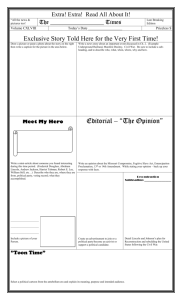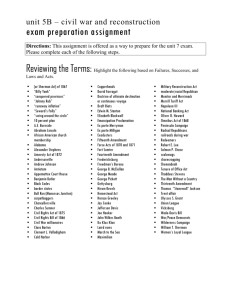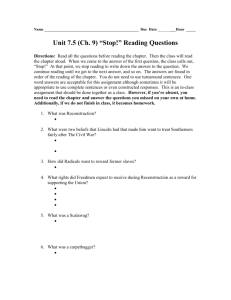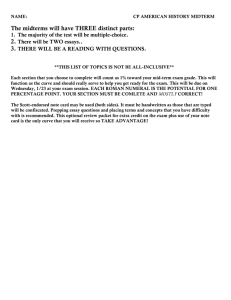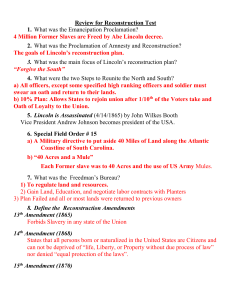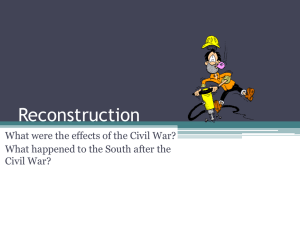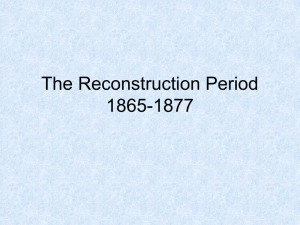A lesson plan for grade 8 - North Carolina State Government
advertisement
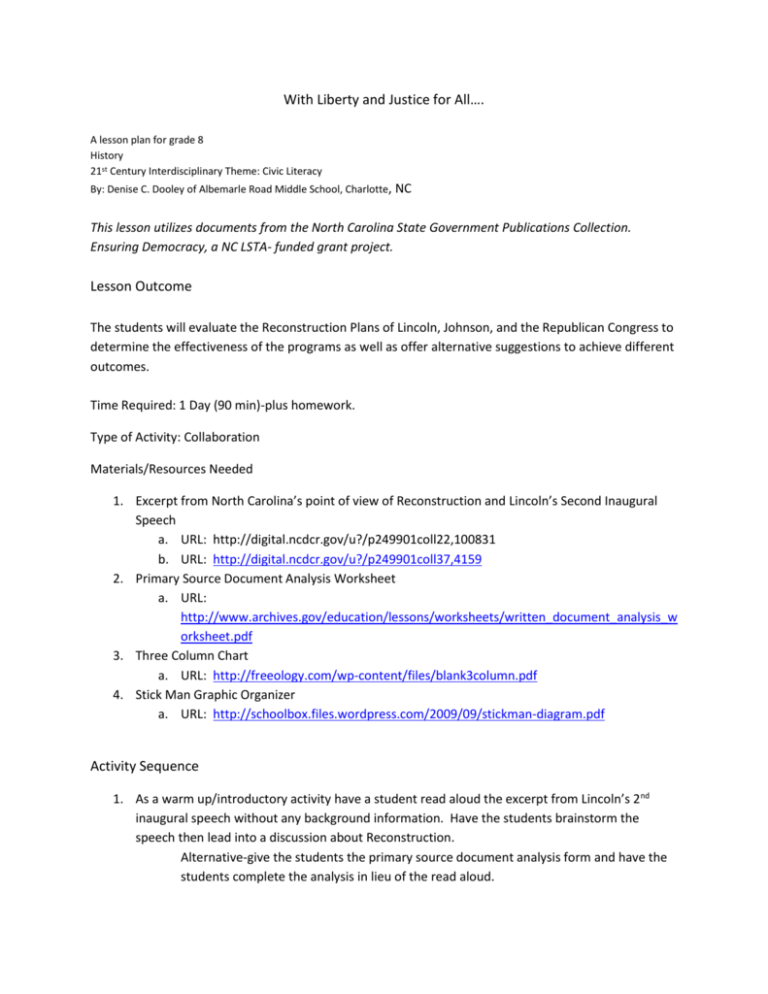
With Liberty and Justice for All…. A lesson plan for grade 8 History 21st Century Interdisciplinary Theme: Civic Literacy By: Denise C. Dooley of Albemarle Road Middle School, Charlotte, NC This lesson utilizes documents from the North Carolina State Government Publications Collection. Ensuring Democracy, a NC LSTA- funded grant project. Lesson Outcome The students will evaluate the Reconstruction Plans of Lincoln, Johnson, and the Republican Congress to determine the effectiveness of the programs as well as offer alternative suggestions to achieve different outcomes. Time Required: 1 Day (90 min)-plus homework. Type of Activity: Collaboration Materials/Resources Needed 1. Excerpt from North Carolina’s point of view of Reconstruction and Lincoln’s Second Inaugural Speech a. URL: http://digital.ncdcr.gov/u?/p249901coll22,100831 b. URL: http://digital.ncdcr.gov/u?/p249901coll37,4159 2. Primary Source Document Analysis Worksheet a. URL: http://www.archives.gov/education/lessons/worksheets/written_document_analysis_w orksheet.pdf 3. Three Column Chart a. URL: http://freeology.com/wp-content/files/blank3column.pdf 4. Stick Man Graphic Organizer a. URL: http://schoolbox.files.wordpress.com/2009/09/stickman-diagram.pdf Activity Sequence 1. As a warm up/introductory activity have a student read aloud the excerpt from Lincoln’s 2nd inaugural speech without any background information. Have the students brainstorm the speech then lead into a discussion about Reconstruction. Alternative-give the students the primary source document analysis form and have the students complete the analysis in lieu of the read aloud. 2. Have the students complete the graphic organizer describing an emancipated slave, the leading statement for the graphic organizer is I don’t have ……………. Have the students write that statement at the top of the paper and on each line complete the ending of the statement. This is to determine what type of services an emancipated slave might need. a. For example, “I don’t have” at the top of the paper and on one of the lines by a hand the student could put “a job” or “money” b. Make sure they put an “I don’t have by all of the lines on the organizer.” 3. Group students into groups of two and have them complete the 3 column chart comparing Lincoln’s, Johnson’s and Congress’ Reconstruction Plan using the information attached at the end of this document. 4. Have the students create a Reconstruction plan that they believe would have made the Reconstruction Era successful by using the “I don’t have” graphic organizer. As an example take the “I don’t have” an education statement-a remedy would be schools, or job education. 5. Finally have the students write a one page paper explaining the programs and why they believe the plans were unsuccessful. This can be done as homework or as an activity in collaboration with the language arts department. Assessment Rubric attached. North Carolina Essential Standards 8.H.1.2 Summarize the literal meaning of historical documents in order to establish context. 8.H.1.3 Use primary and secondary sources to interpret various historical perspectives. 8.H.2.1 Explain the impact of economic, political, social, and military conflicts (e.g. war, slavery, states’ rights and citizenship and immigration policies) on the development of North Carolina and the United States. Albemarle Road Middle School With Liberty and Justice for All Name: ________________________ Date______ Criteria Points 4 3 2 1 Main/Topic Idea Sentence Main/Topic idea sentence is clear, correctly placed, and is restated in the closing sentence. Main/Topic idea sentence is either unclear or incorrectly placed, and is restated in the closing sentence. Main/Topic idea sentence is unclear and incorrectly placed, and is restated in the closing sentence. Main/Topic idea sentence is unclear and incorrectly placed, and is not restated in the closing sentence. ____ Supporting Detail Sentence(s) Paragraph(s) have three or more supporting detail sentences that relate back to the main idea. Paragraph(s) have two supporting detail sentences that relate back to the main idea. Paragraph(s) have one supporting detail sentence that relate back to the main idea. Paragraph(s) have no supporting detail sentences that relate back to the main idea. ____ Elaborating Detail Sentence(s) Each supporting detail sentence has three or more elaborating detail sentences. Each supporting detail sentence has at least two elaborating detail sentences. Each supporting detail sentence has one elaborating detail sentence. Each supporting detail sentence has no elaborating detail sentence. ____ Legibility Legible handwriting, typing, or printing. Marginally legible handwriting, typing, or printing. Writing is not legible in places. Writing is not legible. ____ Paragraph has no errors in punctuation, capitalization, and spelling. Paragraph has one or two punctuation, capitalization, and spelling errors. Paragraph has three to five punctuation, capitalization, and spelling errors. Paragraph has six or more punctuation, capitalization, and spelling errors. ____ Total----> ____ Mechanics and Grammar Powered by TeAch-nology.com- The Web Portal For Educators! (www.teach-nology.com) Lincoln’s Plan Lincoln’s blueprint for Reconstruction included the Ten-Percent Plan, which specified that a southern state could be readmitted into the Union once 10 percent of its voters (from the voter rolls for the election of 1860) swore an oath of allegiance to the Union. Voters could then elect delegates to draft revised state constitutions and establish new state governments. All southerners except for high-ranking Confederate army officers and government officials would be granted a full pardon. Lincoln guaranteed southerners that he would protect their private property, though not their slaves. Most moderate Republicans in Congress supported the president’s proposal for Reconstruction because they wanted to bring a quick end to the war. Lincoln wanted to end the war quickly. He feared that a protracted war would lose public support and that the North and South would never be reunited if the fighting did not stop quickly. His fears were justified: by late 1863, a large number of Democrats were clamoring for a truce and peaceful resolution. Lincoln’s Ten-Percent Plan was thus lenient—an attempt to entice the South to surrender. President Lincoln seemed to favor self-Reconstruction by the states with little assistance from Washington. To appeal to poorer whites, he offered to pardon all Confederates; to appeal to former plantation owners and southern aristocrats, he pledged to protect private property. Unlike Radical Republicans in Congress, Lincoln did not want to punish southerners or reorganize southern society. His actions indicate that he wanted Reconstruction to be a short process in which secessionist states could draft new constitutions as swiftly as possible so that the United States could exist as it had before. But historians can only speculate that Lincoln desired a swift reunification, for his assassination in 1865 cut his plans for Reconstruction short. Johnson's Plan On April 9, 1865 the Civil War ended. Lincoln was assassinated a few days later and Vice President Andrew Johnson became the new president. Johnson came up with his own Reconstruction plan in May 1865. His plan offered pardons to every single southern white, not including the main Confederate leaders and rich Confederate supporters. The southern states that were defeated were to hold conventions and start new state governments. These new state governments had to abolish slavery and agree to be loyal to the country if they wanted to rejoin the Union. New state governments were started in the summer and fall of 1865. Congressional Reconstruction Plan Believed the South should be punished for starting the war and hoped to protect the rights of Freedmen (former slaves). Extended the Freedmen's Bureau (Over Johnson's Veto) to provide food, clothing, shelter, and education to freedmen and war refugees. Civil Rights Act of 1866 (Passed over Johnson's Veto) designed to grant freedmen full legal equality, undercutting the Black Codes Reconstruction Act of 1867 (Passed over Johnson's Veto) Divided the South into 5 districts and placed them under military rule (disbanded governments readmitted under Lincoln/Johnson plans Required S. States to ratify the 14th Amendment Guaranteed freedmen the right to vote in conventions to write new state constitutions Sources http://library.thinkquest.org/J0112391/reconstruction.htm http://www.icsd.k12.ny.us/legacy/highschool/pjordan/ushonors/Regents%20Review/Manifest%20Desti ny%20to%20Reconstruct/reconstruction.html http://www.ohiohistorycentral.org/entry.php?rec=626 www.teach-nology.com
